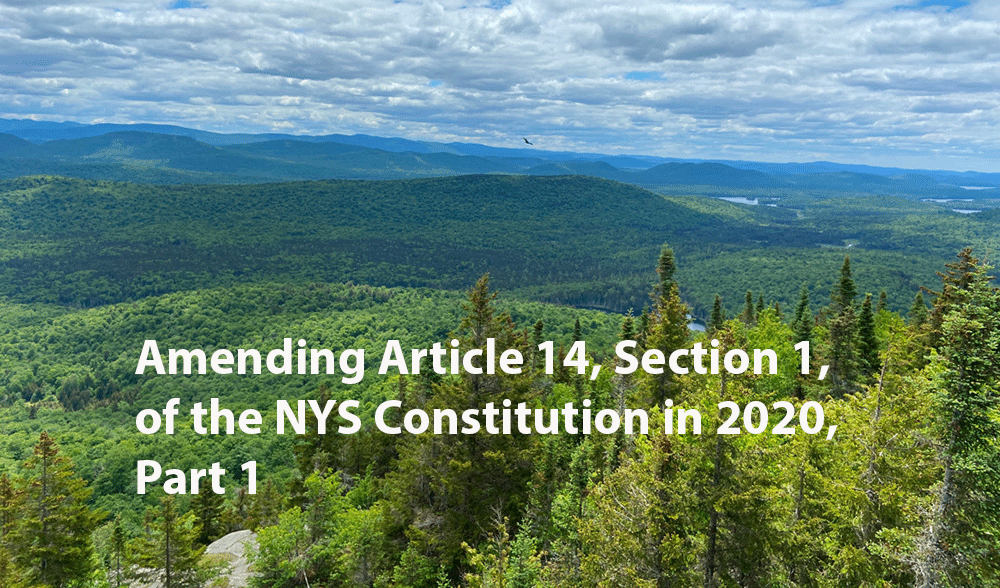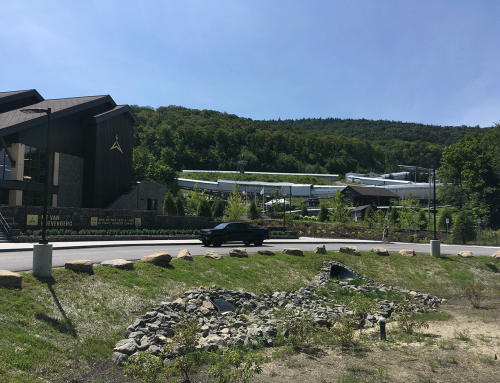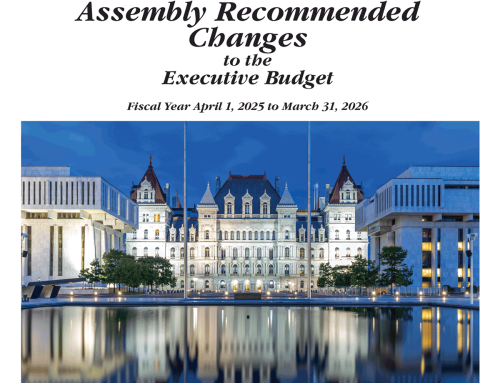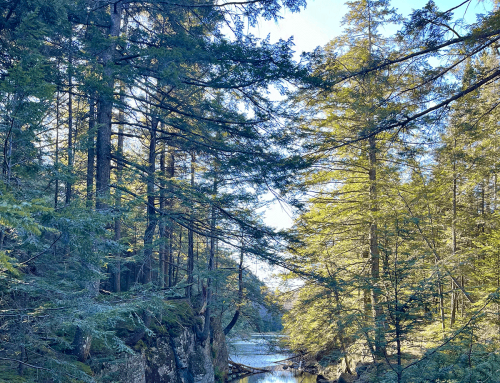Article 14, Section 1, of the New York Constitution, the famed “Forever Wild” provision, has been amended 16 times since 1938. It has been amended five times since 2007, making this period the most active and intensive in Forest Preserve history for amendments.
Several Article 14, Section 1 proposed amendments are being drafted and organized by the Department of Environmental Conservation and Cuomo Administration that focus on bringing the Mt. Van Hoevenberg Winter Sports Complex (pictured here) into compliance with Article 14, removing the former Camp Gabriels prison complex from the Forest Preserve, and for locating an emergency communications tower on, and possibly providing public access, to Cathead Mountain in southern Hamilton County, which would involve neighboring Forest Preserve.
This article is the first of five that looks at Article 14 amendments in general, the three amendments currently being organized, and the hangover from the NYCO amendment in 2013. The second article in this series focuses on the Mt. Van Hoevenberg Olympic Winter Sports Complex managed by the Olympic Regional Development Authority. The third part focuses on Camp Gabriels, the former prison in the Town of Brighton. The fourth focuses on Hamilton County’s plans to try and place an emergency communications tower on Cathead Mountain, which while the mountain summit is privately owned it is surrounded by Forest Preserve that would need to be accessed for power lines and a motor vehicle road. All of these amendments are in the early stages of development. The fifth article looks at the passage of the NYCO amendment, which raised serious questions about public accountability.
Here is the original text for Article 14, Section 1:
“The lands of the state, now owned or hereafter acquired, constituting the forest preserve as now fixed by law, shall be forever kept as wild forest lands. They shall not be leased, sold or exchanged, or be taken by any corporation, public or private, nor shall the timber thereon be sold, removed or destroyed.”
The 3-million-acre public Forest Preserve is one of the great achievements of the State of New York. The Forest Preserve today contains over 90 percent of the designated Wilderness areas in the 11 states of the northeastern United States. Since 1885, the Forest Preserve has been the beneficiary of a multi-generational and bipartisan commitment to the protection of wildlands, including a vast array of unique ecosystems, and abundant outdoor recreational opportunities. The Forest Preserve is accessible free of charge and is open 24/7. The Forest Preserve is the economic cornerstone for scores of communities in the Adirondacks and Catskills.
The New York Constitution is a covenant between the governed and governing, between the People and the State. All legislators swear an oath to uphold the Constitution. Since 1894, the public Forest Preserve in the Adirondack and Catskill Parks has been protected in the NYS Constitution so that all major decisions about the welfare of the Forest Preserve must be made by the People and not by the Governor, state agencies, or the Legislature. Major decisions include removing lands from the Forest Preserve or significantly altering the use and condition of these lands. These are decisions that must be made by the People of the State of New York.
These are extraordinary times, unlike anything that any of us have lived through before, with the COVID-19 pandemic and the state shutdown. Despite these challenges, there are still important public policy issues in the Adirondack Park that would be best dealt with in 2020. Protect the Adirondacks has researched various options for potential amendments to Article 14, Section 1 of the NYS Constitution, the famed Forever Wild provision. These proposed amendments would help to resolve intractable problems facing Adirondack Park communities and management of the public Forest Preserve. These possible amendments include Mt. Van Hoevenberg, Camp Gabriels, and Cathead Mountain where Hamilton County is seeking to site an emergency communications tower.
Past Recent Amendments
The State of New York has approved constitutional amendments to Article 14, Section 1, 16 times since the 1938 Constitutional Convention, which produced New York’s current Constitution. The is a rate of one amendment roughly every five years. Seven of the 16 have been in Hamilton County, with four alone in the Raquette Lake area:
November 4, 1941: Whiteface Mountain Ski Area
November 4, 1947: State Ski Areas Gore, Belleayre
November 5, 1957: DOT State Highways Land Bank
November 3, 1959: Adirondack Northway
November 5, 1963: Saranac Lake Landfill
November 2, 1965: Piseco Airport Runway Expansion-1
November 6, 1979: Perkins Clearing Land Swap w/ International Paper Company (8,500 acres Forest Preserve for 8,500 acres IP lands)
November 8, 1983: Sagamore Institute Not-for-Profit -1 (saving Great Camp Sagamore)
November 3, 1987: Sagamore Institute Not-for-Profit -2 (saving Great Camp Sagamore)
November 5, 1991: Piseco Airport Runway Expansion-2
November 7, 1995: Town of Keene Cemetery
November 6, 2007: Raquette Lake Water Supply
November 3, 2009: Route 56 Powerline
November 5, 2013: Township 40
November 5, 2013: NYCO
November 7, 2017: Health & Safety Land Account
An Article 14 amendment is a necessary tool for managing the dynamic and unique Adirondack Park. Since 1938, the State of New York has built a major highway through the eastern Adirondacks, added over 800,000 acres to the public Forest Preserve in the Adirondack Park, purchased over 750,000 acres of conservation easements, and instituted a unique regional land use plan for the 92 towns and 9 villages within the Adirondack Park Blue Line through the Adirondack Park Agency Act. Adirondack Park is an evolving and dynamic place that requires minor changes to Article 14, Section 1, to meet local needs or resolve an Adirondack Park management or public welfare problem.
The bar is set high for any amendment to the NYS Constitution. An amendment requires passage in two successive legislatures, known commonly as First Passage and Second Passage, and then approval by a vote of the People of the State of New York. Despite the high bar for amending the State Constitution, Article 14, Section 1 amendments have been relatively commonplace in New York over the last 82 years.
Article 14 is the most frequently amended part of the Constitution due to the fact that in many towns in the Adirondack and Catskill Parks, Forest Preserve ownership is often very high, being over 50 percent in many communities and even higher in more than a dozen. At times this high level of public Forest Preserve ownership has created serious challenges for municipalities to provide basic services. This is why the 16 successful amendments to Article 14, Section 1 saw legislative action for First or Second Passage in 30 of the 41 Legislatures convened since 1939.
The political calendar makes action on a proposed amendment to the State Constitution advantageous in 2020. If First Passage is approved by the Legislature in 2020, then Second Passage could be approved in 2021, followed by a vote by the People of the State of New York in November 2021. If First Passage is delayed until 2021, then Second Passage and a vote of the People will not be available until 2023 at the earliest. This would significantly delay the resolution of major problems facing the Forest Preserve and Adirondack communities.
The Legislative “Tests” for Assessing the Validity of an Amendment of Article 14, Section 1
Article 14 amendments are generally constructed in two ways. The first is through what has come to be called a “use” amendment. The second is what has come to be called a “land swap.”
Under a use amendment, a new use on the Forest Preserve is allowed. Examples of a “use” amendment include the amendments that approved the development of alpine ski areas at Gore and Whiteface Mountains:
November 4, 1941: Whiteface Mountain Ski Area
nor from constructing and maintaining not more than twenty-five miles of ski trails thirty to two hundred feet wide, together with appurtenances thereto, provided that no more than five miles of such trails shall be in excess of one hundred twenty feet wide, on the north, east and northwest slopes of Whiteface Mountain in Essex county.November 4, 1947: State Ski Areas Gore, Belleayre
nor from constructing and maintaining not more than twenty-five miles of ski trails thirty to two hundred feet wide, together with appurtenances thereto, provided that no more than two miles of such trails shall be in excess of one hundred twenty feet wide, on the slopes of Belleayre Mountain in Ulster and Delaware counties and not more than forty miles of ski trails thirty to two hundred feet wide, together with appurtenances thereto, provided that no more than eight miles of such trails shall be in excess of one hundred twenty feet wide, on the slopes of Gore and Pete Gay mountains in Warren county.
Other use amendments include the 1957 Department of Transportation “Highways Land Bank” to manage state highways bordered by Forest Preserve.
In recent years, the “land swap” amendment has been more common. Here, lands are authorized to be removed from the Forest Preserve on condition that lands of equal or greater value are purchased and added to compensate the Forest Preserve. Due to the fact that all amendments must be voted on by the People of State of New York, the acreage coming into the Forest Preserve is usually much greater than the acreage going out, to make the draft amendment compelling for a yes vote. Purchase of new lands are also used to make use amendments more salable to the public.
Recent examples of land swap amendments include the Saranac Lake landfill in 1963, both of the amendments for the Piseco Airport (1965, 1991), Town of Keene Cemetery in 1995, and Raquette Lake Water Supply in 2007. Here’s the language for the Raquette Lake Water Supply:
November 6, 2007: Raquette Lake Water Supply
Notwithstanding the foregoing provisions and subject to legislative approval prior to actual transfer of title, because there is no viable alternative to using forest preserve lands for the siting of drinking water wells and necessary appurtenances and because such wells are necessary to meet drinking water quality standards, the state may convey to the town of Long Lake, Hamilton county, one acre of forest preserve land within such town for public use as the site of such drinking water wells and necessary appurtenances for the municipal water supply for the hamlet of Raquette Lake. In exchange therefor, the town of Long Lake shall convey to the state at least twelve acres of land located in Hamilton county for incorporation into the forest preserve that the legislature shall determine is at least equal in value to the land to be conveyed by the state. The Raquette Lake surface reservoir shall be abandoned as a drinking water supply source.
The three amendments currently under consideration would utilize the use or land swap amendment formats.
Article 14 amendments are a necessary tool for managing a complex and dynamic place like the Adirondack Park. They have been used regularly, yet sparingly, over the last 80 years. There are three under consideration now, and there will undoubtedly be more used in the future. Each draft amendment is scrutinized by private organizations and local governments. Each draft amendment is subject to legislative review for First and Second Passage and a vote by the People of the State of New York.






